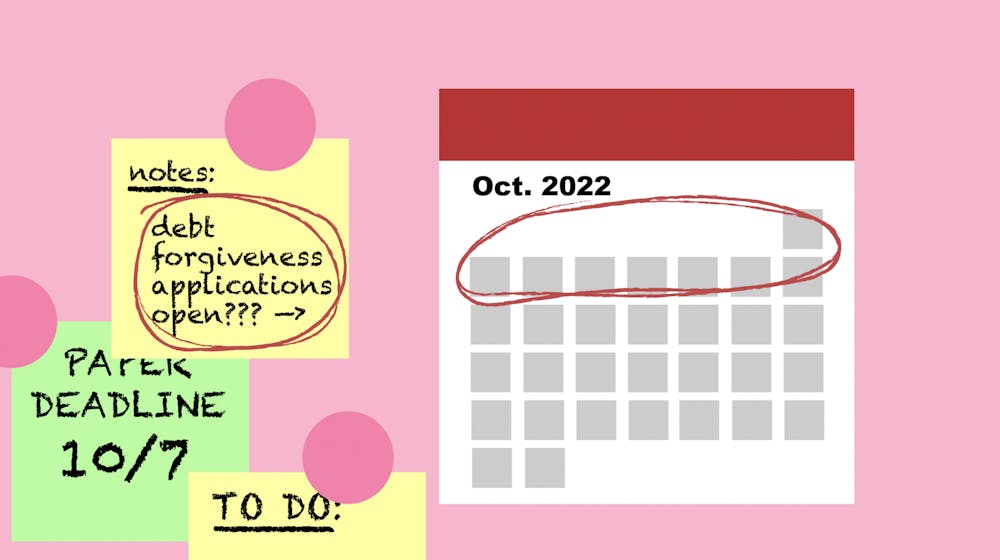Just ahead of the application period, access to sweeping nationwide student debt relief is now narrower at best and nonexistent at worst.
The White House announced Sept. 29 its debt forgiveness plan will no longer apply to around 770,000 private loan borrowers, even if the loans are guaranteed by the federal government. The change came on the same day six states filed a joint lawsuit against the Biden administration to block the plan.
President Joe Biden proposed up to $20,000 in forgiveness for borrowers who make less than $125,000 annually and received a Pell Grant — a program awarding college funding to students with exceptional financial need — in August. Borrowers who make less than $125,000 annually but didn’t receive a Pell Grant would be eligible for up to $10,000 in relief, per the plan.
Biden’s administration hasn’t yet opened or released any specifics of the application, but it has detailed steps borrowers can take to check their eligibility and prepare to apply.
Jazmin Sanders, a 26-year-old manager at a cybersecurity company and Gainesville resident, is eligible for the full $20,000 in relief as a Pell Grant recipient. The plan reduces some of the $30,000 in debt she accumulated through federal loans she used to attend UF, save for one she took out privately.
After years of hearing about possible loan forgiveness, Sanders said she’s glad to see some action toward climbing student debt, which totals $1.75 trillion among graduates nationwide.
“I feel like America’s finally coming around,” she said.
The provisions originally applied to borrowers who took out student loans through the federal government or had their private student loans guaranteed by the federal government. Guaranteed private loans is when the government assumes responsibility for paying 97% of the original loan amount to the private lender if the borrower is unable to do so. Now, Americans with their loans guaranteed by the federal government won’t see any of their debt forgiven if the loans are unconsolidated, even if they meet all other criteria.
Borrowers who planned to consolidate existing loans — or pay off a collection of loans with a single, larger loan from the federal government — were eligible for the program prior to Sept. 29. But new guidelines will only grant relief to those who applied to consolidate their loans with a federal loan prior to Sept. 29.
As it stands, those who meet the federal consolidation criteria or took loans directly from the government are eligible for relief. That includes at least 15% of UF students who, according to data from the Department of Education, took out federal loans to complete their degrees.
Seventy percent of UF undergraduates complete their degrees debt-free, UF spokesperson Cynthia Roldan wrote in an email. A number of those students, like Alexa Cole, chose to attend UF to ensure they fell into that category and avoided accumulating debt at other schools.
Cole, a 21-year-old UF computer engineering senior, was accepted to universities out of state as a senior in high school. But as a Boca Raton native, she qualified for in-state tuition at UF, which was covered by the Florida Prepaid program fund her parents set up for her.
Like 23,000 UF students, according to statistics from the UF Office of Student Financial Aid and Scholarships, Cole also qualified for the Bright Futures scholarship. The scholarship completely covers tuition for in-state students who earn the Florida Academic Scholars Award, which requires a 3.0 cumulative GPA.
Cole wanted to attend schools out of state, but the choice came down to cost, she said.
“I would either be $200,000 in debt or if I went to Florida — because I had prepaid and Bright Futures — I’d be able to actually have money,” Cole said.
Though the plan doesn’t apply to her, Cole said debt forgiveness provides necessary relief for alumni like her cousin, a UF graduate who completed both the dental and orthodontic program in the College of Dentistry.
“I think it was a really good decision,” she said. “There are people that really needed it.”
No certain timeline exists, but the Biden administration said applications for loan forgiveness will open within the next few weeks and close Dec. 31, 2023. The application doesn’t require any supporting documents, according to a post from the president’s Instagram account.
Borrowers are encouraged to apply before Nov. 15 so the government can approve their application before the national payment freeze expires at the end of the year. Biden extended the freeze, which pauses required monthly payments, to lessen the economic pressures of the COVID-19 pandemic and its lingering effects.
The plan would wipe away thousands of dollars in debt from some 43 million Americans — if it makes it to the other side of a federal lawsuit.
Representatives from Arkansas. Iowa, Kansas, Missouri, Nebraska and South Carolina, all GOP-controlled states, sued the Biden administration Sept. 29 for alleged harm to loan providers. The suit argues that Biden’s forgiveness incentivizes borrowers to consolidate their loans through the federal government instead of paying them off to banks or private lenders, eliminating interest and curbing the companies’ essential revenue sources.
Legal representatives for the states also claim the White House has no authority to waive millions of dollars in debt. Biden pointed to the 2003 Higher Education Relief Opportunities for Students Act, which allowed the federal government to alter financial aid program regulations in the aftermath of 9/11, as precedent, but the suit says no overarching statute grants his office the ability to clear debt on such a massive scale.
“In addition to being economically unwise and inherently unfair, the Biden Administration’s Mass Debt Cancellation is another example in a long line of unlawful regulatory actions,” the office of Nebraska Attorney General Doug Peterson wrote in a news release.
Arizona Attorney General Mark Brnovich hinted at a similar lawsuit on behalf of his state, and a public interest lawyer also pushed back on the forgiveness plan on the grounds of abuse of executive power. But experts say the case holds little weight, CNN reported.
The stricter applicant conditions may lessen the plan’s legal uncertainties. With the consolidation deadline already passed, private borrowers no longer benefit from consolidating their loans federally, erasing the incentive to abandon their existing agreements.
For now, the forgiveness plan stands, and eligible applicants could see some of their debt cleared as soon as four weeks after applying.
Kelley Graham, a 25-year-old UF law graduate, qualifies for $10,000 of relief on her $52,000 in debt. Though the plan doesn’t completely erase her debt, Graham said she was relieved to see a portion of it forgiven.
“I was like, ‘Well there goes some of it,’” she said.
Graduates across the country have claimed $20,000 isn’t enough to significantly aid in relieving debt and called for complete forgiveness, but Graham said she sees this wave of relief as the first step in long-term debt policy.
Graham’s thankful to see some debt forgiveness for herself and others in the short term, she said.
“I wish it could be more, but I understand that they can only do a little bit right now,” she said. “People are mad about it, but I’m like, ‘Feel better for the people that it’s helping.’”
Contact Heather at hbushman@alligator.org. Follow her on Twitter @hmb_1013.

Heather Bushman is a fourth-year journalism and political science student and the enterprise elections reporter. She previously wrote and edited for the Avenue desk and reported for WUFT News. You can usually find her writing, listening to music or writing about listening to music. Ask her about synesthesia or her album tier list sometime.






